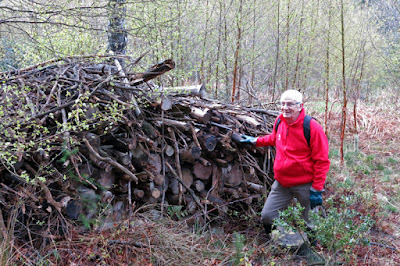11th May 2016
As a rule, sheep are docile, unimaginative creatures,
capable of no more than munching grass all day, reproducing once a year, and
occasionally falling over with their feet sticking up in the air. It’s their upbringing,
you see. Natural selection has long since been replaced by farmer selection.
They are bred for the quality of their meat and wool, their reproductive
success rate, and their good looks – so that they can win prizes in
agricultural shows. Wit and survival skills are not selection criteria.
It was unexpected then that, after all our hard
work, sheep dismantled a gate at the penned-in Warrenhaugh Pond, kicked sticks
and straw out of the way, and ate all the green grass cuttings from the grass
snake nest heap. It’s repaired now, and defences strengthened using hammer,
nails and string. We know how to out-wit sheep.
 |
| We hope you're not accusing us... |
 |
| The heap being repaired. |
 |
| The gate repaired. |
Our wits weren’t so sharp when we volunteered to
shift the debris of some recently felled trees from the Ladyhaugh end of the
Monument vista. The National Trust likes its vistas. It was a simple enough
task and, we had thought, an easy one: shifting logs and branches out of line
of sight – nothing to it. We were wrong. Job finished, we barely had strength
enough to sit in the sunshine and lift a cup of coffee and sandwich to the lips.
We should have got the sheep to do it.
 |
| Two views of the improved vista. |
Then it was time for a bit of nature watching befor heading back to base...
 |
| Greater stitchwort. |
 |
| Wood horsetail |
 |
| Bugles |
 |
| Toothwrt. |
Steve Wootten & Phil Coyne






















